Biohazard Waste Management: Alternative Solutions and Considerations
VerifiedAdded on 2021/04/21
|23
|6044
|28
Report
AI Summary
This report provides an in-depth analysis of alternative solutions for biohazard waste management, focusing on the considerations necessary for selecting the most effective and sustainable methods. The research evaluates various technologies, including incineration, non-incineration procedures like microwave irradiation and chemical methods, and plasma pyrolysis, considering their environmental, social, and economic implications. The selection methodology emphasizes human health concerns and environmental conservation, taking into account factors such as public preferences, cultural aspects, and the availability of skilled personnel. The report also addresses the importance of aligning waste management strategies with cultural practices and the need for cost-effective and sustainable solutions, ensuring that the chosen alternative promotes both human health and environmental well-being. The report emphasizes the importance of considering social factors like public preferences, cultural and religious aspects, and the availability of skills when implementing waste management systems.

PROFESSIONAL SKILLS IN ENGINEERING
By Name
Course
Instructor
Institution
Location
Date
By Name
Course
Instructor
Institution
Location
Date
Paraphrase This Document
Need a fresh take? Get an instant paraphrase of this document with our AI Paraphraser

1. Executive Summary
This portfolio presents a research that has been conducted on the various alternative solutions to
the effective bio-hazard waste management systems. Various considerations are taken into
account before an alternative option can be selected on including environmental, social,
economic considerations. All these considerations are aimed at achieving the best alternative that
will not only serve the interest of the hospitals and the healthcare centers but also the
surrounding environment. Various considerations that are in these categories form the basis for
making an informed decision on an alternative solution.
This portfolio presents a research that has been conducted on the various alternative solutions to
the effective bio-hazard waste management systems. Various considerations are taken into
account before an alternative option can be selected on including environmental, social,
economic considerations. All these considerations are aimed at achieving the best alternative that
will not only serve the interest of the hospitals and the healthcare centers but also the
surrounding environment. Various considerations that are in these categories form the basis for
making an informed decision on an alternative solution.
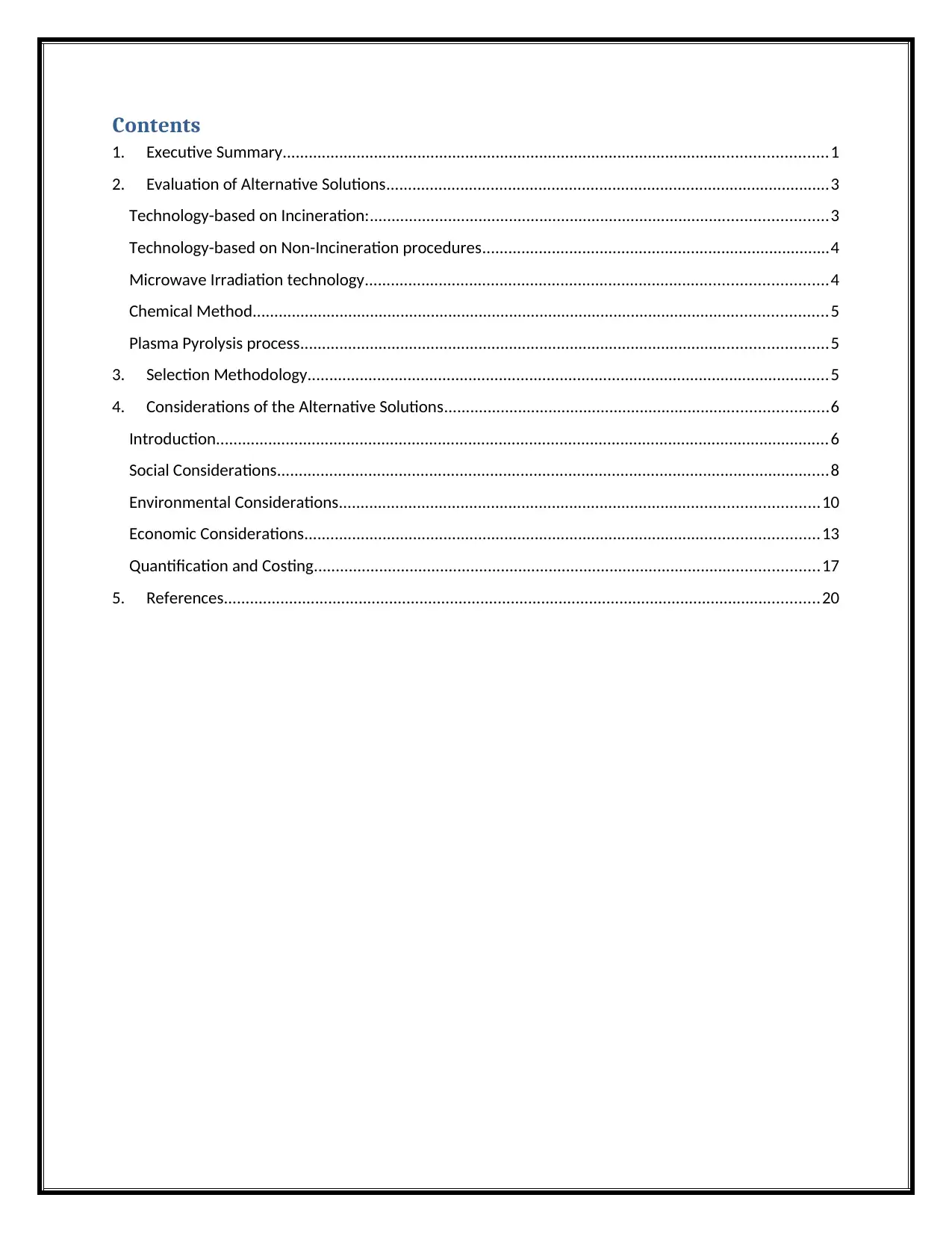
Contents
1. Executive Summary.............................................................................................................................1
2. Evaluation of Alternative Solutions......................................................................................................3
Technology-based on Incineration:.........................................................................................................3
Technology-based on Non-Incineration procedures................................................................................4
Microwave Irradiation technology..........................................................................................................4
Chemical Method....................................................................................................................................5
Plasma Pyrolysis process.........................................................................................................................5
3. Selection Methodology........................................................................................................................5
4. Considerations of the Alternative Solutions........................................................................................6
Introduction.............................................................................................................................................6
Social Considerations...............................................................................................................................8
Environmental Considerations..............................................................................................................10
Economic Considerations......................................................................................................................13
Quantification and Costing....................................................................................................................17
5. References.........................................................................................................................................20
1. Executive Summary.............................................................................................................................1
2. Evaluation of Alternative Solutions......................................................................................................3
Technology-based on Incineration:.........................................................................................................3
Technology-based on Non-Incineration procedures................................................................................4
Microwave Irradiation technology..........................................................................................................4
Chemical Method....................................................................................................................................5
Plasma Pyrolysis process.........................................................................................................................5
3. Selection Methodology........................................................................................................................5
4. Considerations of the Alternative Solutions........................................................................................6
Introduction.............................................................................................................................................6
Social Considerations...............................................................................................................................8
Environmental Considerations..............................................................................................................10
Economic Considerations......................................................................................................................13
Quantification and Costing....................................................................................................................17
5. References.........................................................................................................................................20
⊘ This is a preview!⊘
Do you want full access?
Subscribe today to unlock all pages.

Trusted by 1+ million students worldwide
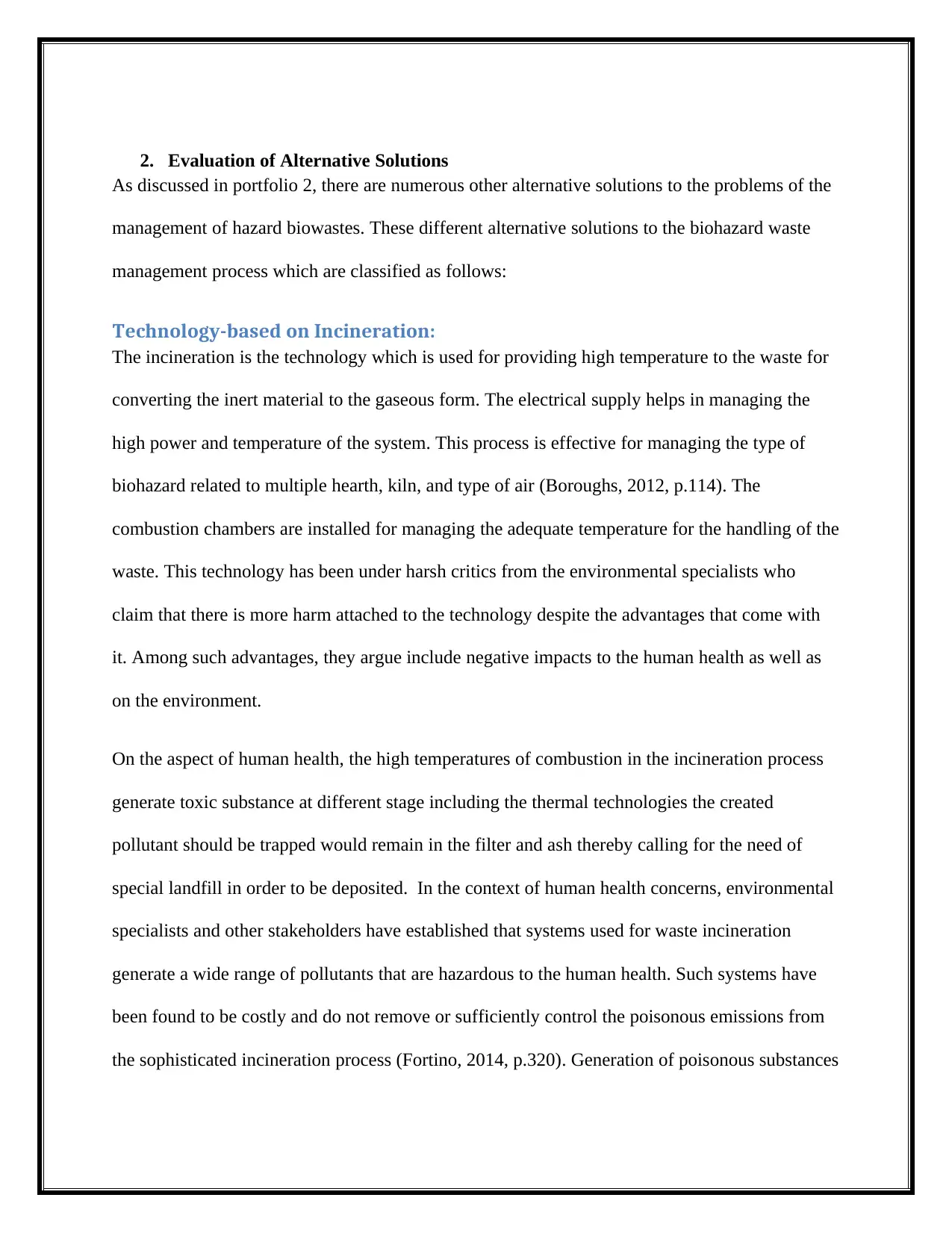
2. Evaluation of Alternative Solutions
As discussed in portfolio 2, there are numerous other alternative solutions to the problems of the
management of hazard biowastes. These different alternative solutions to the biohazard waste
management process which are classified as follows:
Technology-based on Incineration:
The incineration is the technology which is used for providing high temperature to the waste for
converting the inert material to the gaseous form. The electrical supply helps in managing the
high power and temperature of the system. This process is effective for managing the type of
biohazard related to multiple hearth, kiln, and type of air (Boroughs, 2012, p.114). The
combustion chambers are installed for managing the adequate temperature for the handling of the
waste. This technology has been under harsh critics from the environmental specialists who
claim that there is more harm attached to the technology despite the advantages that come with
it. Among such advantages, they argue include negative impacts to the human health as well as
on the environment.
On the aspect of human health, the high temperatures of combustion in the incineration process
generate toxic substance at different stage including the thermal technologies the created
pollutant should be trapped would remain in the filter and ash thereby calling for the need of
special landfill in order to be deposited. In the context of human health concerns, environmental
specialists and other stakeholders have established that systems used for waste incineration
generate a wide range of pollutants that are hazardous to the human health. Such systems have
been found to be costly and do not remove or sufficiently control the poisonous emissions from
the sophisticated incineration process (Fortino, 2014, p.320). Generation of poisonous substances
As discussed in portfolio 2, there are numerous other alternative solutions to the problems of the
management of hazard biowastes. These different alternative solutions to the biohazard waste
management process which are classified as follows:
Technology-based on Incineration:
The incineration is the technology which is used for providing high temperature to the waste for
converting the inert material to the gaseous form. The electrical supply helps in managing the
high power and temperature of the system. This process is effective for managing the type of
biohazard related to multiple hearth, kiln, and type of air (Boroughs, 2012, p.114). The
combustion chambers are installed for managing the adequate temperature for the handling of the
waste. This technology has been under harsh critics from the environmental specialists who
claim that there is more harm attached to the technology despite the advantages that come with
it. Among such advantages, they argue include negative impacts to the human health as well as
on the environment.
On the aspect of human health, the high temperatures of combustion in the incineration process
generate toxic substance at different stage including the thermal technologies the created
pollutant should be trapped would remain in the filter and ash thereby calling for the need of
special landfill in order to be deposited. In the context of human health concerns, environmental
specialists and other stakeholders have established that systems used for waste incineration
generate a wide range of pollutants that are hazardous to the human health. Such systems have
been found to be costly and do not remove or sufficiently control the poisonous emissions from
the sophisticated incineration process (Fortino, 2014, p.320). Generation of poisonous substances
Paraphrase This Document
Need a fresh take? Get an instant paraphrase of this document with our AI Paraphraser
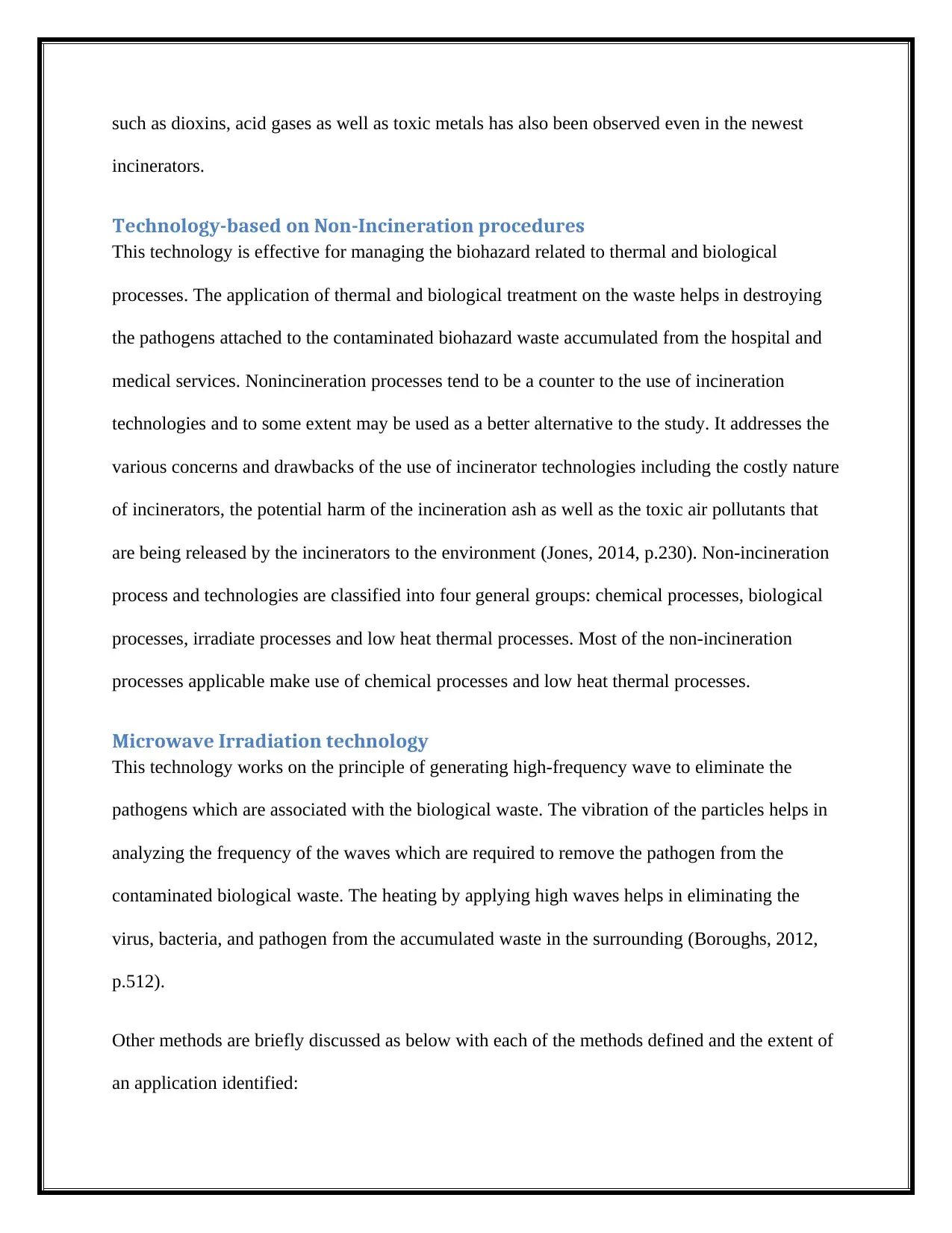
such as dioxins, acid gases as well as toxic metals has also been observed even in the newest
incinerators.
Technology-based on Non-Incineration procedures
This technology is effective for managing the biohazard related to thermal and biological
processes. The application of thermal and biological treatment on the waste helps in destroying
the pathogens attached to the contaminated biohazard waste accumulated from the hospital and
medical services. Nonincineration processes tend to be a counter to the use of incineration
technologies and to some extent may be used as a better alternative to the study. It addresses the
various concerns and drawbacks of the use of incinerator technologies including the costly nature
of incinerators, the potential harm of the incineration ash as well as the toxic air pollutants that
are being released by the incinerators to the environment (Jones, 2014, p.230). Non-incineration
process and technologies are classified into four general groups: chemical processes, biological
processes, irradiate processes and low heat thermal processes. Most of the non-incineration
processes applicable make use of chemical processes and low heat thermal processes.
Microwave Irradiation technology
This technology works on the principle of generating high-frequency wave to eliminate the
pathogens which are associated with the biological waste. The vibration of the particles helps in
analyzing the frequency of the waves which are required to remove the pathogen from the
contaminated biological waste. The heating by applying high waves helps in eliminating the
virus, bacteria, and pathogen from the accumulated waste in the surrounding (Boroughs, 2012,
p.512).
Other methods are briefly discussed as below with each of the methods defined and the extent of
an application identified:
incinerators.
Technology-based on Non-Incineration procedures
This technology is effective for managing the biohazard related to thermal and biological
processes. The application of thermal and biological treatment on the waste helps in destroying
the pathogens attached to the contaminated biohazard waste accumulated from the hospital and
medical services. Nonincineration processes tend to be a counter to the use of incineration
technologies and to some extent may be used as a better alternative to the study. It addresses the
various concerns and drawbacks of the use of incinerator technologies including the costly nature
of incinerators, the potential harm of the incineration ash as well as the toxic air pollutants that
are being released by the incinerators to the environment (Jones, 2014, p.230). Non-incineration
process and technologies are classified into four general groups: chemical processes, biological
processes, irradiate processes and low heat thermal processes. Most of the non-incineration
processes applicable make use of chemical processes and low heat thermal processes.
Microwave Irradiation technology
This technology works on the principle of generating high-frequency wave to eliminate the
pathogens which are associated with the biological waste. The vibration of the particles helps in
analyzing the frequency of the waves which are required to remove the pathogen from the
contaminated biological waste. The heating by applying high waves helps in eliminating the
virus, bacteria, and pathogen from the accumulated waste in the surrounding (Boroughs, 2012,
p.512).
Other methods are briefly discussed as below with each of the methods defined and the extent of
an application identified:
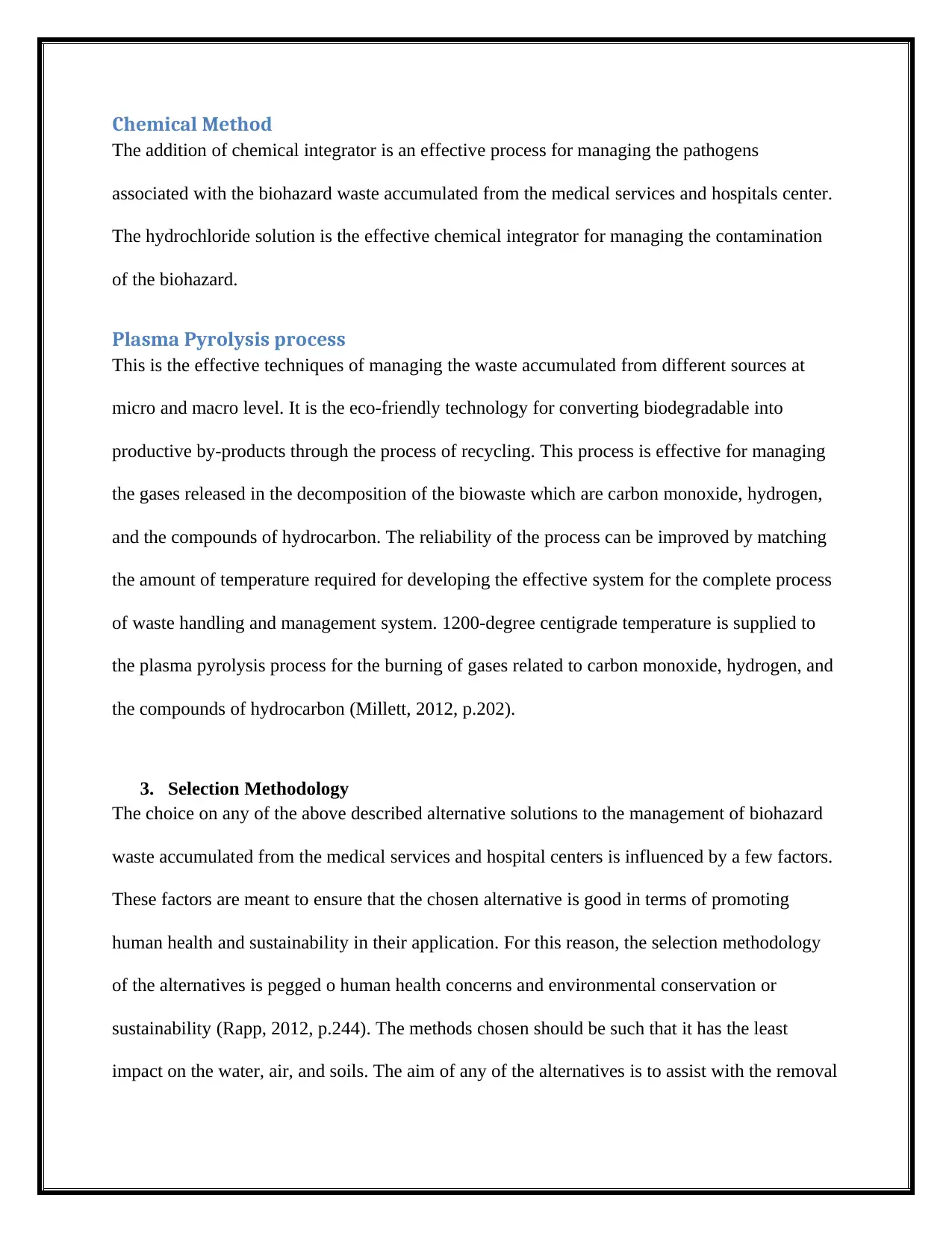
Chemical Method
The addition of chemical integrator is an effective process for managing the pathogens
associated with the biohazard waste accumulated from the medical services and hospitals center.
The hydrochloride solution is the effective chemical integrator for managing the contamination
of the biohazard.
Plasma Pyrolysis process
This is the effective techniques of managing the waste accumulated from different sources at
micro and macro level. It is the eco-friendly technology for converting biodegradable into
productive by-products through the process of recycling. This process is effective for managing
the gases released in the decomposition of the biowaste which are carbon monoxide, hydrogen,
and the compounds of hydrocarbon. The reliability of the process can be improved by matching
the amount of temperature required for developing the effective system for the complete process
of waste handling and management system. 1200-degree centigrade temperature is supplied to
the plasma pyrolysis process for the burning of gases related to carbon monoxide, hydrogen, and
the compounds of hydrocarbon (Millett, 2012, p.202).
3. Selection Methodology
The choice on any of the above described alternative solutions to the management of biohazard
waste accumulated from the medical services and hospital centers is influenced by a few factors.
These factors are meant to ensure that the chosen alternative is good in terms of promoting
human health and sustainability in their application. For this reason, the selection methodology
of the alternatives is pegged o human health concerns and environmental conservation or
sustainability (Rapp, 2012, p.244). The methods chosen should be such that it has the least
impact on the water, air, and soils. The aim of any of the alternatives is to assist with the removal
The addition of chemical integrator is an effective process for managing the pathogens
associated with the biohazard waste accumulated from the medical services and hospitals center.
The hydrochloride solution is the effective chemical integrator for managing the contamination
of the biohazard.
Plasma Pyrolysis process
This is the effective techniques of managing the waste accumulated from different sources at
micro and macro level. It is the eco-friendly technology for converting biodegradable into
productive by-products through the process of recycling. This process is effective for managing
the gases released in the decomposition of the biowaste which are carbon monoxide, hydrogen,
and the compounds of hydrocarbon. The reliability of the process can be improved by matching
the amount of temperature required for developing the effective system for the complete process
of waste handling and management system. 1200-degree centigrade temperature is supplied to
the plasma pyrolysis process for the burning of gases related to carbon monoxide, hydrogen, and
the compounds of hydrocarbon (Millett, 2012, p.202).
3. Selection Methodology
The choice on any of the above described alternative solutions to the management of biohazard
waste accumulated from the medical services and hospital centers is influenced by a few factors.
These factors are meant to ensure that the chosen alternative is good in terms of promoting
human health and sustainability in their application. For this reason, the selection methodology
of the alternatives is pegged o human health concerns and environmental conservation or
sustainability (Rapp, 2012, p.244). The methods chosen should be such that it has the least
impact on the water, air, and soils. The aim of any of the alternatives is to assist with the removal
⊘ This is a preview!⊘
Do you want full access?
Subscribe today to unlock all pages.

Trusted by 1+ million students worldwide
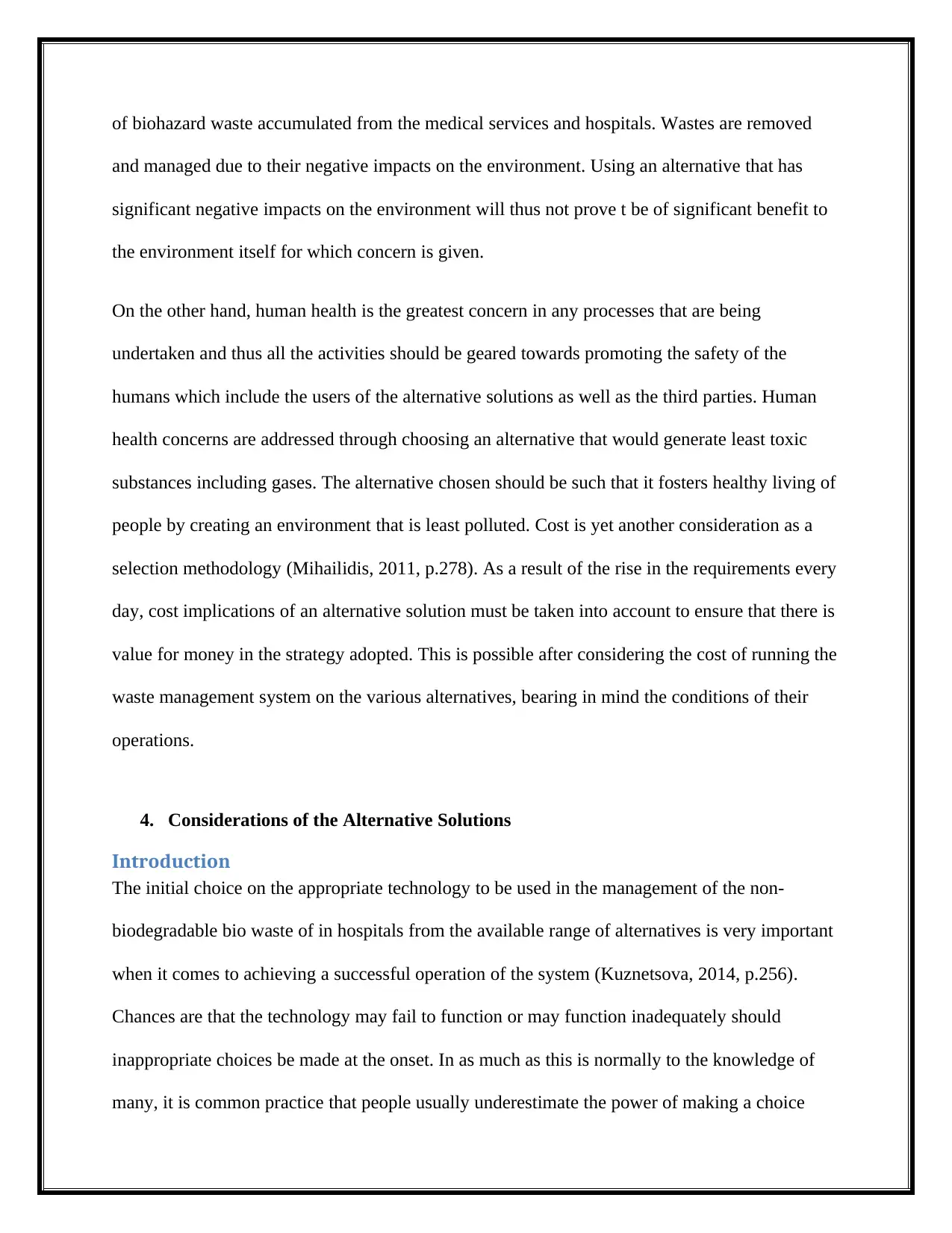
of biohazard waste accumulated from the medical services and hospitals. Wastes are removed
and managed due to their negative impacts on the environment. Using an alternative that has
significant negative impacts on the environment will thus not prove t be of significant benefit to
the environment itself for which concern is given.
On the other hand, human health is the greatest concern in any processes that are being
undertaken and thus all the activities should be geared towards promoting the safety of the
humans which include the users of the alternative solutions as well as the third parties. Human
health concerns are addressed through choosing an alternative that would generate least toxic
substances including gases. The alternative chosen should be such that it fosters healthy living of
people by creating an environment that is least polluted. Cost is yet another consideration as a
selection methodology (Mihailidis, 2011, p.278). As a result of the rise in the requirements every
day, cost implications of an alternative solution must be taken into account to ensure that there is
value for money in the strategy adopted. This is possible after considering the cost of running the
waste management system on the various alternatives, bearing in mind the conditions of their
operations.
4. Considerations of the Alternative Solutions
Introduction
The initial choice on the appropriate technology to be used in the management of the non-
biodegradable bio waste of in hospitals from the available range of alternatives is very important
when it comes to achieving a successful operation of the system (Kuznetsova, 2014, p.256).
Chances are that the technology may fail to function or may function inadequately should
inappropriate choices be made at the onset. In as much as this is normally to the knowledge of
many, it is common practice that people usually underestimate the power of making a choice
and managed due to their negative impacts on the environment. Using an alternative that has
significant negative impacts on the environment will thus not prove t be of significant benefit to
the environment itself for which concern is given.
On the other hand, human health is the greatest concern in any processes that are being
undertaken and thus all the activities should be geared towards promoting the safety of the
humans which include the users of the alternative solutions as well as the third parties. Human
health concerns are addressed through choosing an alternative that would generate least toxic
substances including gases. The alternative chosen should be such that it fosters healthy living of
people by creating an environment that is least polluted. Cost is yet another consideration as a
selection methodology (Mihailidis, 2011, p.278). As a result of the rise in the requirements every
day, cost implications of an alternative solution must be taken into account to ensure that there is
value for money in the strategy adopted. This is possible after considering the cost of running the
waste management system on the various alternatives, bearing in mind the conditions of their
operations.
4. Considerations of the Alternative Solutions
Introduction
The initial choice on the appropriate technology to be used in the management of the non-
biodegradable bio waste of in hospitals from the available range of alternatives is very important
when it comes to achieving a successful operation of the system (Kuznetsova, 2014, p.256).
Chances are that the technology may fail to function or may function inadequately should
inappropriate choices be made at the onset. In as much as this is normally to the knowledge of
many, it is common practice that people usually underestimate the power of making a choice
Paraphrase This Document
Need a fresh take? Get an instant paraphrase of this document with our AI Paraphraser
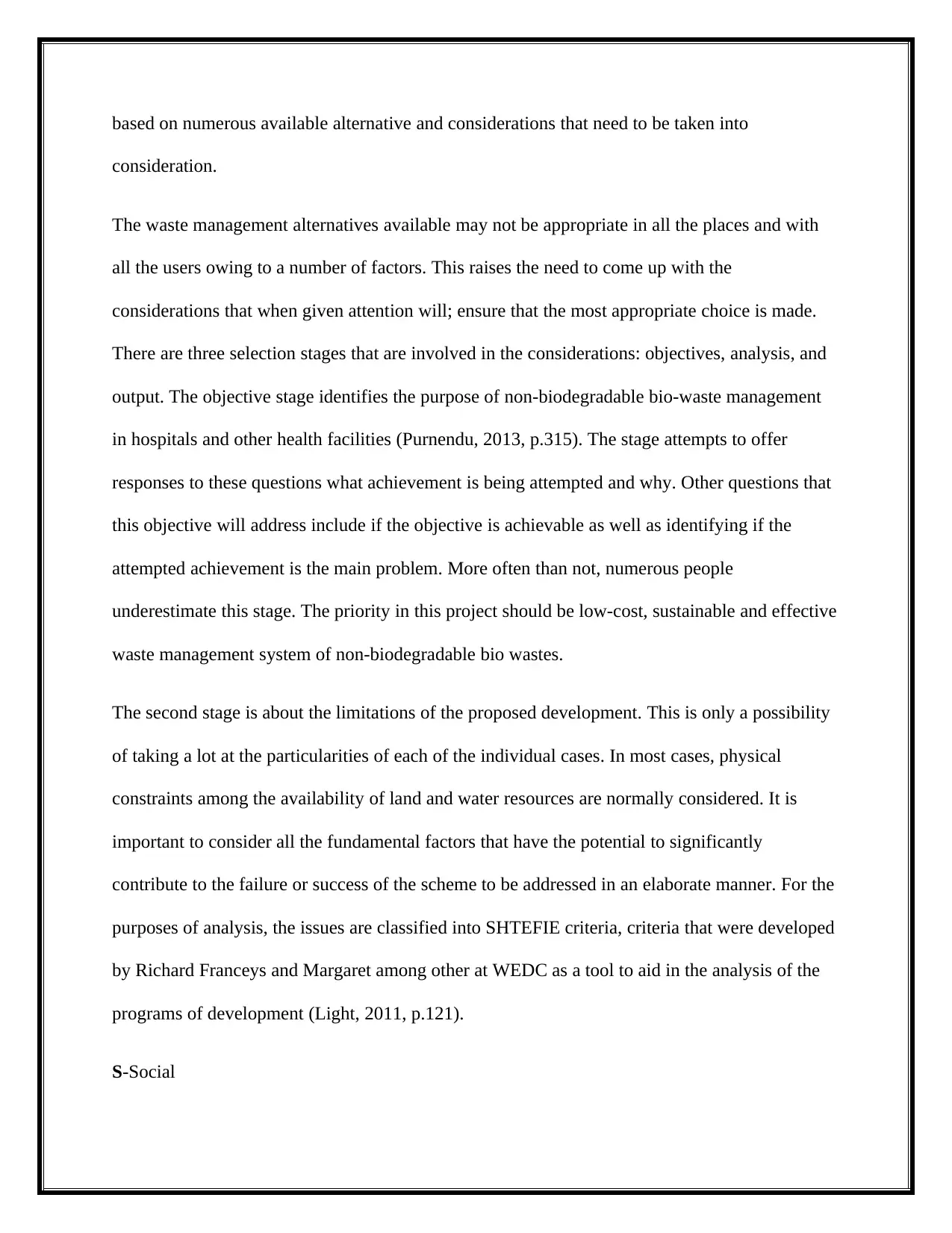
based on numerous available alternative and considerations that need to be taken into
consideration.
The waste management alternatives available may not be appropriate in all the places and with
all the users owing to a number of factors. This raises the need to come up with the
considerations that when given attention will; ensure that the most appropriate choice is made.
There are three selection stages that are involved in the considerations: objectives, analysis, and
output. The objective stage identifies the purpose of non-biodegradable bio-waste management
in hospitals and other health facilities (Purnendu, 2013, p.315). The stage attempts to offer
responses to these questions what achievement is being attempted and why. Other questions that
this objective will address include if the objective is achievable as well as identifying if the
attempted achievement is the main problem. More often than not, numerous people
underestimate this stage. The priority in this project should be low-cost, sustainable and effective
waste management system of non-biodegradable bio wastes.
The second stage is about the limitations of the proposed development. This is only a possibility
of taking a lot at the particularities of each of the individual cases. In most cases, physical
constraints among the availability of land and water resources are normally considered. It is
important to consider all the fundamental factors that have the potential to significantly
contribute to the failure or success of the scheme to be addressed in an elaborate manner. For the
purposes of analysis, the issues are classified into SHTEFIE criteria, criteria that were developed
by Richard Franceys and Margaret among other at WEDC as a tool to aid in the analysis of the
programs of development (Light, 2011, p.121).
S-Social
consideration.
The waste management alternatives available may not be appropriate in all the places and with
all the users owing to a number of factors. This raises the need to come up with the
considerations that when given attention will; ensure that the most appropriate choice is made.
There are three selection stages that are involved in the considerations: objectives, analysis, and
output. The objective stage identifies the purpose of non-biodegradable bio-waste management
in hospitals and other health facilities (Purnendu, 2013, p.315). The stage attempts to offer
responses to these questions what achievement is being attempted and why. Other questions that
this objective will address include if the objective is achievable as well as identifying if the
attempted achievement is the main problem. More often than not, numerous people
underestimate this stage. The priority in this project should be low-cost, sustainable and effective
waste management system of non-biodegradable bio wastes.
The second stage is about the limitations of the proposed development. This is only a possibility
of taking a lot at the particularities of each of the individual cases. In most cases, physical
constraints among the availability of land and water resources are normally considered. It is
important to consider all the fundamental factors that have the potential to significantly
contribute to the failure or success of the scheme to be addressed in an elaborate manner. For the
purposes of analysis, the issues are classified into SHTEFIE criteria, criteria that were developed
by Richard Franceys and Margaret among other at WEDC as a tool to aid in the analysis of the
programs of development (Light, 2011, p.121).
S-Social
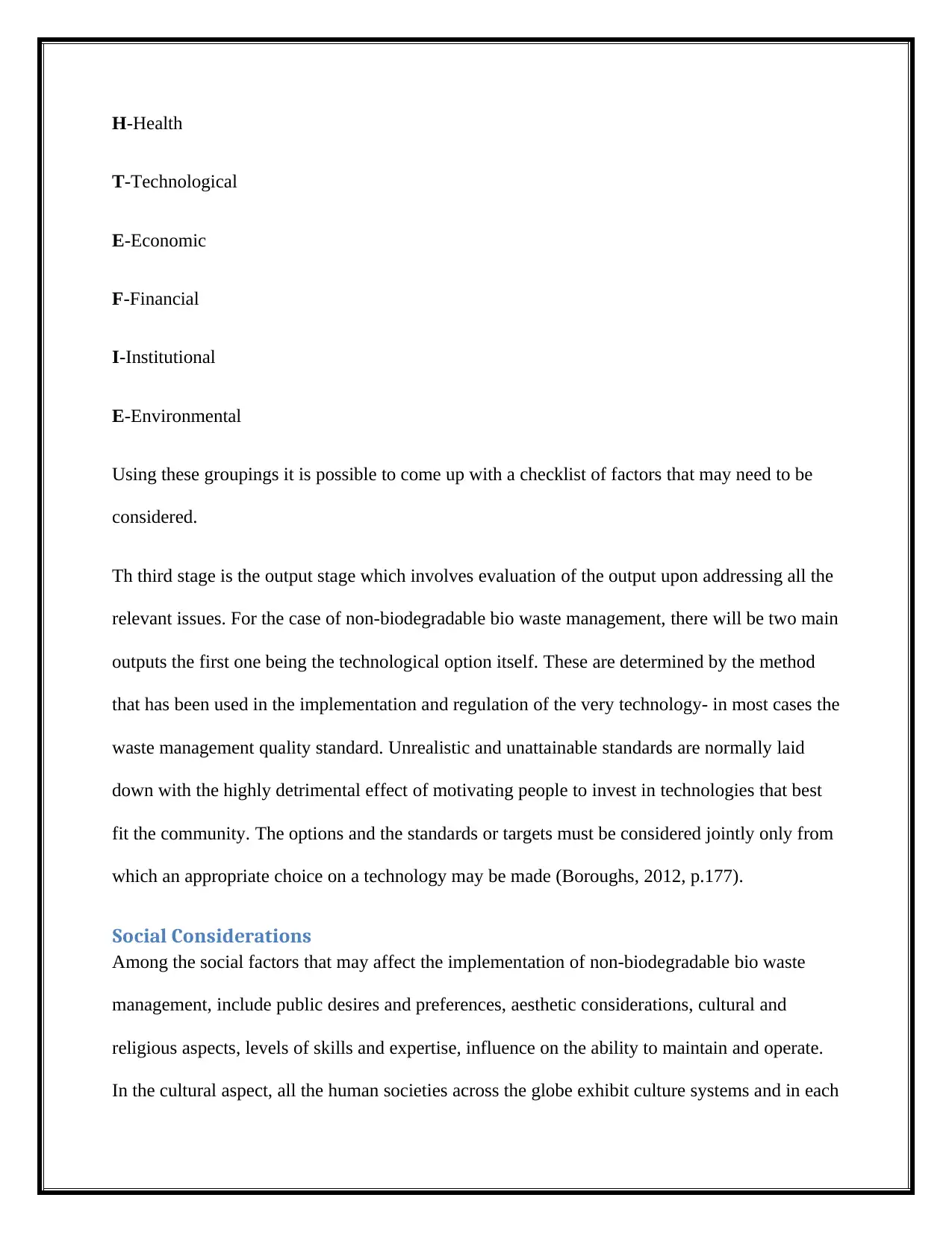
H-Health
T-Technological
E-Economic
F-Financial
I-Institutional
E-Environmental
Using these groupings it is possible to come up with a checklist of factors that may need to be
considered.
Th third stage is the output stage which involves evaluation of the output upon addressing all the
relevant issues. For the case of non-biodegradable bio waste management, there will be two main
outputs the first one being the technological option itself. These are determined by the method
that has been used in the implementation and regulation of the very technology- in most cases the
waste management quality standard. Unrealistic and unattainable standards are normally laid
down with the highly detrimental effect of motivating people to invest in technologies that best
fit the community. The options and the standards or targets must be considered jointly only from
which an appropriate choice on a technology may be made (Boroughs, 2012, p.177).
Social Considerations
Among the social factors that may affect the implementation of non-biodegradable bio waste
management, include public desires and preferences, aesthetic considerations, cultural and
religious aspects, levels of skills and expertise, influence on the ability to maintain and operate.
In the cultural aspect, all the human societies across the globe exhibit culture systems and in each
T-Technological
E-Economic
F-Financial
I-Institutional
E-Environmental
Using these groupings it is possible to come up with a checklist of factors that may need to be
considered.
Th third stage is the output stage which involves evaluation of the output upon addressing all the
relevant issues. For the case of non-biodegradable bio waste management, there will be two main
outputs the first one being the technological option itself. These are determined by the method
that has been used in the implementation and regulation of the very technology- in most cases the
waste management quality standard. Unrealistic and unattainable standards are normally laid
down with the highly detrimental effect of motivating people to invest in technologies that best
fit the community. The options and the standards or targets must be considered jointly only from
which an appropriate choice on a technology may be made (Boroughs, 2012, p.177).
Social Considerations
Among the social factors that may affect the implementation of non-biodegradable bio waste
management, include public desires and preferences, aesthetic considerations, cultural and
religious aspects, levels of skills and expertise, influence on the ability to maintain and operate.
In the cultural aspect, all the human societies across the globe exhibit culture systems and in each
⊘ This is a preview!⊘
Do you want full access?
Subscribe today to unlock all pages.

Trusted by 1+ million students worldwide
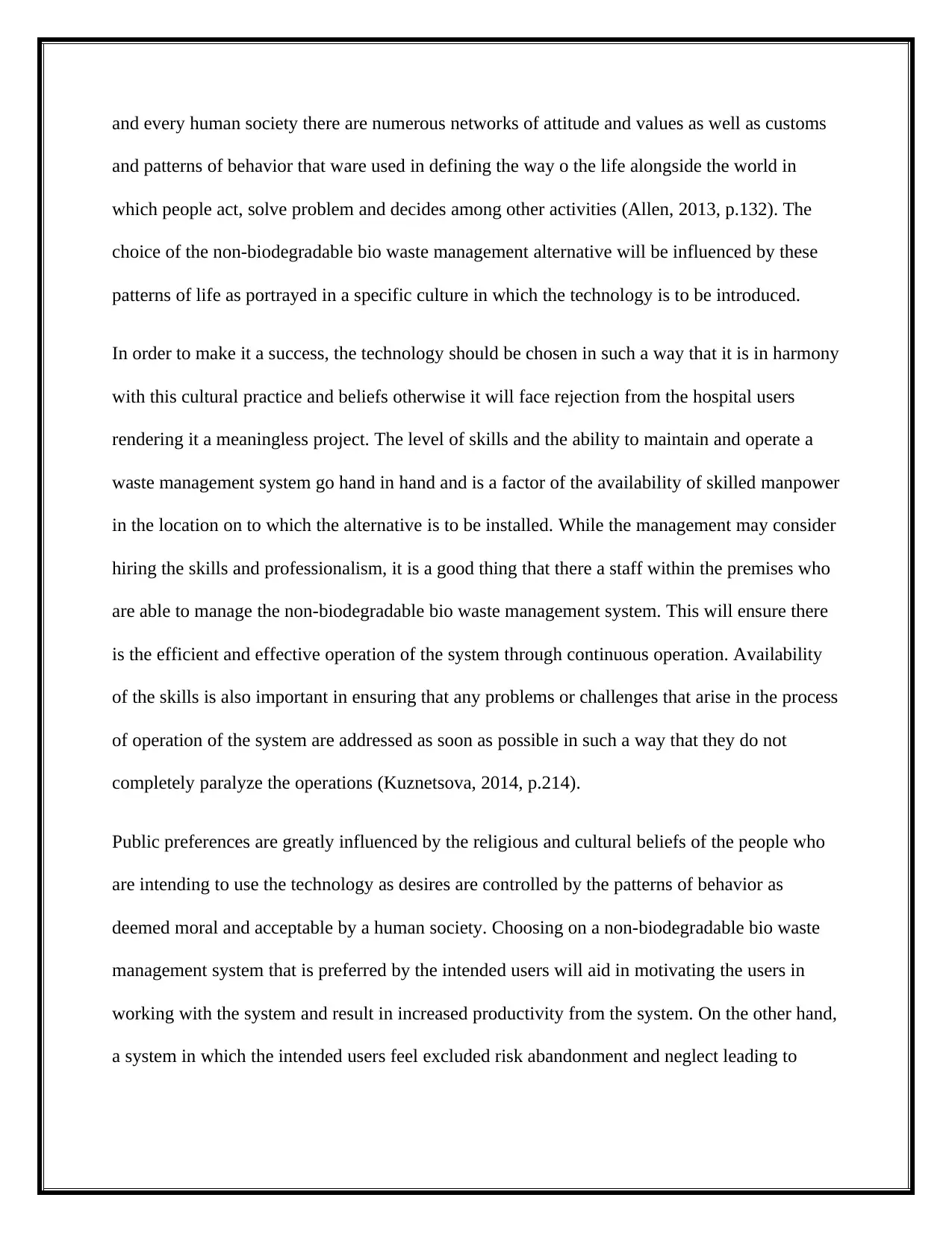
and every human society there are numerous networks of attitude and values as well as customs
and patterns of behavior that ware used in defining the way o the life alongside the world in
which people act, solve problem and decides among other activities (Allen, 2013, p.132). The
choice of the non-biodegradable bio waste management alternative will be influenced by these
patterns of life as portrayed in a specific culture in which the technology is to be introduced.
In order to make it a success, the technology should be chosen in such a way that it is in harmony
with this cultural practice and beliefs otherwise it will face rejection from the hospital users
rendering it a meaningless project. The level of skills and the ability to maintain and operate a
waste management system go hand in hand and is a factor of the availability of skilled manpower
in the location on to which the alternative is to be installed. While the management may consider
hiring the skills and professionalism, it is a good thing that there a staff within the premises who
are able to manage the non-biodegradable bio waste management system. This will ensure there
is the efficient and effective operation of the system through continuous operation. Availability
of the skills is also important in ensuring that any problems or challenges that arise in the process
of operation of the system are addressed as soon as possible in such a way that they do not
completely paralyze the operations (Kuznetsova, 2014, p.214).
Public preferences are greatly influenced by the religious and cultural beliefs of the people who
are intending to use the technology as desires are controlled by the patterns of behavior as
deemed moral and acceptable by a human society. Choosing on a non-biodegradable bio waste
management system that is preferred by the intended users will aid in motivating the users in
working with the system and result in increased productivity from the system. On the other hand,
a system in which the intended users feel excluded risk abandonment and neglect leading to
and patterns of behavior that ware used in defining the way o the life alongside the world in
which people act, solve problem and decides among other activities (Allen, 2013, p.132). The
choice of the non-biodegradable bio waste management alternative will be influenced by these
patterns of life as portrayed in a specific culture in which the technology is to be introduced.
In order to make it a success, the technology should be chosen in such a way that it is in harmony
with this cultural practice and beliefs otherwise it will face rejection from the hospital users
rendering it a meaningless project. The level of skills and the ability to maintain and operate a
waste management system go hand in hand and is a factor of the availability of skilled manpower
in the location on to which the alternative is to be installed. While the management may consider
hiring the skills and professionalism, it is a good thing that there a staff within the premises who
are able to manage the non-biodegradable bio waste management system. This will ensure there
is the efficient and effective operation of the system through continuous operation. Availability
of the skills is also important in ensuring that any problems or challenges that arise in the process
of operation of the system are addressed as soon as possible in such a way that they do not
completely paralyze the operations (Kuznetsova, 2014, p.214).
Public preferences are greatly influenced by the religious and cultural beliefs of the people who
are intending to use the technology as desires are controlled by the patterns of behavior as
deemed moral and acceptable by a human society. Choosing on a non-biodegradable bio waste
management system that is preferred by the intended users will aid in motivating the users in
working with the system and result in increased productivity from the system. On the other hand,
a system in which the intended users feel excluded risk abandonment and neglect leading to
Paraphrase This Document
Need a fresh take? Get an instant paraphrase of this document with our AI Paraphraser
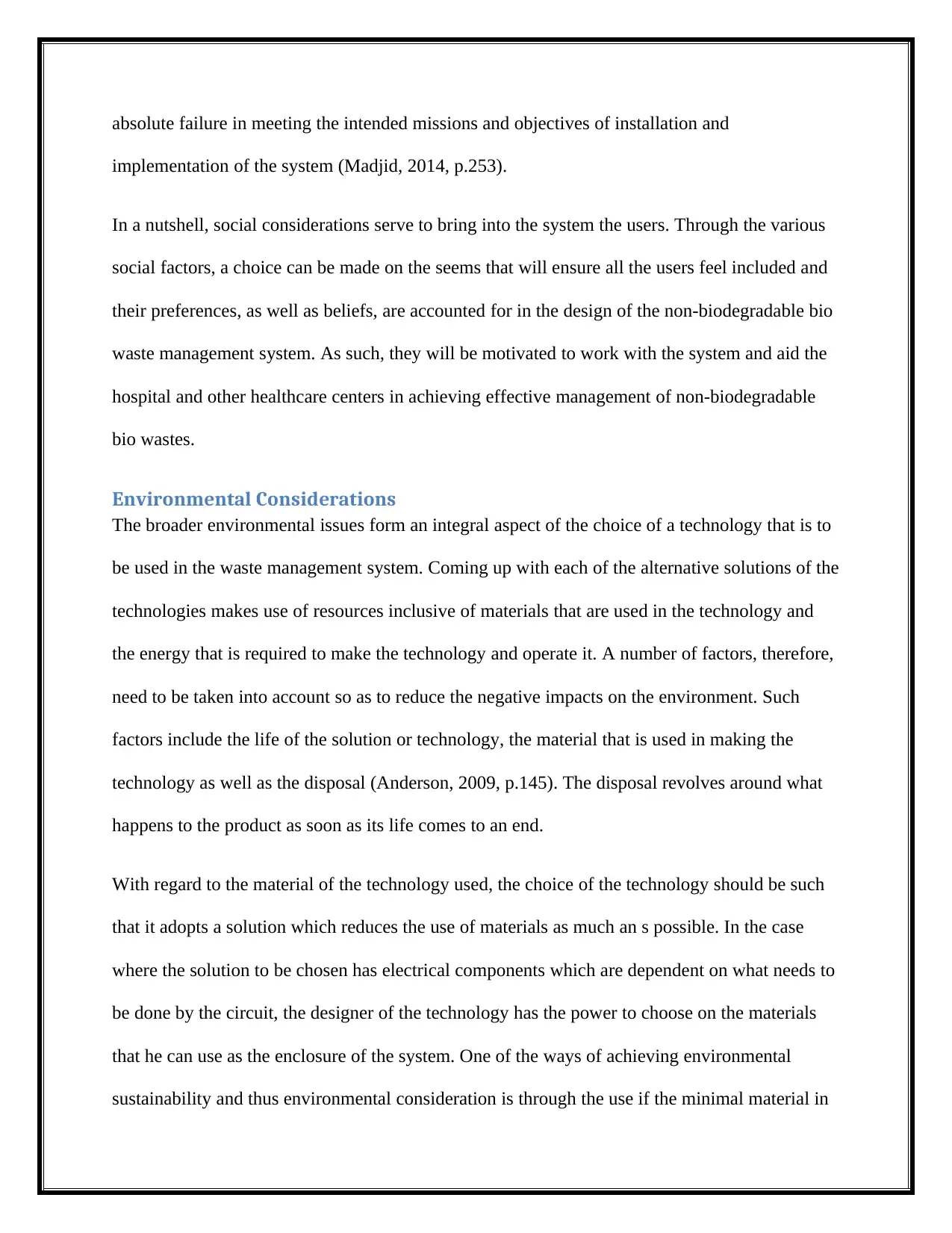
absolute failure in meeting the intended missions and objectives of installation and
implementation of the system (Madjid, 2014, p.253).
In a nutshell, social considerations serve to bring into the system the users. Through the various
social factors, a choice can be made on the seems that will ensure all the users feel included and
their preferences, as well as beliefs, are accounted for in the design of the non-biodegradable bio
waste management system. As such, they will be motivated to work with the system and aid the
hospital and other healthcare centers in achieving effective management of non-biodegradable
bio wastes.
Environmental Considerations
The broader environmental issues form an integral aspect of the choice of a technology that is to
be used in the waste management system. Coming up with each of the alternative solutions of the
technologies makes use of resources inclusive of materials that are used in the technology and
the energy that is required to make the technology and operate it. A number of factors, therefore,
need to be taken into account so as to reduce the negative impacts on the environment. Such
factors include the life of the solution or technology, the material that is used in making the
technology as well as the disposal (Anderson, 2009, p.145). The disposal revolves around what
happens to the product as soon as its life comes to an end.
With regard to the material of the technology used, the choice of the technology should be such
that it adopts a solution which reduces the use of materials as much an s possible. In the case
where the solution to be chosen has electrical components which are dependent on what needs to
be done by the circuit, the designer of the technology has the power to choose on the materials
that he can use as the enclosure of the system. One of the ways of achieving environmental
sustainability and thus environmental consideration is through the use if the minimal material in
implementation of the system (Madjid, 2014, p.253).
In a nutshell, social considerations serve to bring into the system the users. Through the various
social factors, a choice can be made on the seems that will ensure all the users feel included and
their preferences, as well as beliefs, are accounted for in the design of the non-biodegradable bio
waste management system. As such, they will be motivated to work with the system and aid the
hospital and other healthcare centers in achieving effective management of non-biodegradable
bio wastes.
Environmental Considerations
The broader environmental issues form an integral aspect of the choice of a technology that is to
be used in the waste management system. Coming up with each of the alternative solutions of the
technologies makes use of resources inclusive of materials that are used in the technology and
the energy that is required to make the technology and operate it. A number of factors, therefore,
need to be taken into account so as to reduce the negative impacts on the environment. Such
factors include the life of the solution or technology, the material that is used in making the
technology as well as the disposal (Anderson, 2009, p.145). The disposal revolves around what
happens to the product as soon as its life comes to an end.
With regard to the material of the technology used, the choice of the technology should be such
that it adopts a solution which reduces the use of materials as much an s possible. In the case
where the solution to be chosen has electrical components which are dependent on what needs to
be done by the circuit, the designer of the technology has the power to choose on the materials
that he can use as the enclosure of the system. One of the ways of achieving environmental
sustainability and thus environmental consideration is through the use if the minimal material in
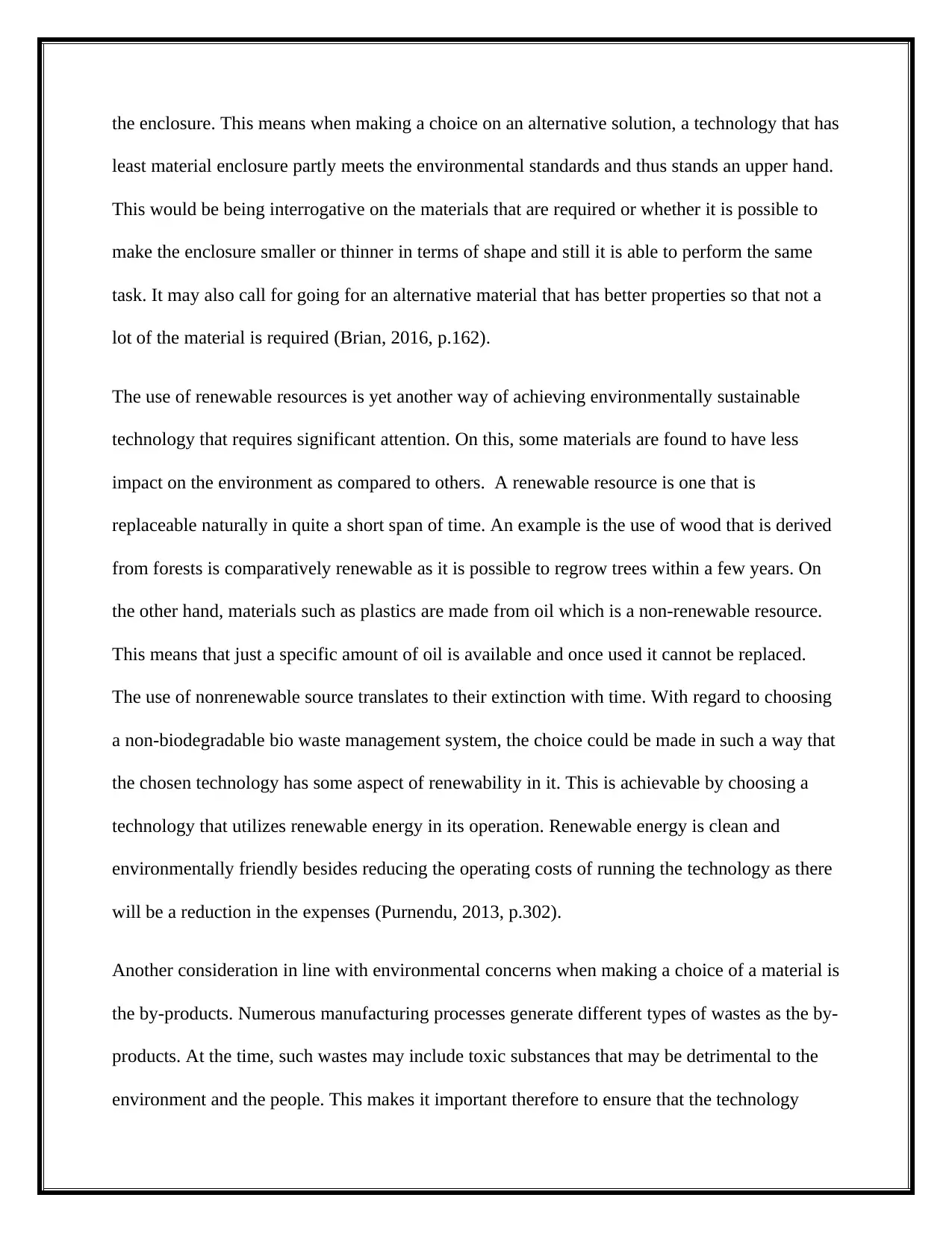
the enclosure. This means when making a choice on an alternative solution, a technology that has
least material enclosure partly meets the environmental standards and thus stands an upper hand.
This would be being interrogative on the materials that are required or whether it is possible to
make the enclosure smaller or thinner in terms of shape and still it is able to perform the same
task. It may also call for going for an alternative material that has better properties so that not a
lot of the material is required (Brian, 2016, p.162).
The use of renewable resources is yet another way of achieving environmentally sustainable
technology that requires significant attention. On this, some materials are found to have less
impact on the environment as compared to others. A renewable resource is one that is
replaceable naturally in quite a short span of time. An example is the use of wood that is derived
from forests is comparatively renewable as it is possible to regrow trees within a few years. On
the other hand, materials such as plastics are made from oil which is a non-renewable resource.
This means that just a specific amount of oil is available and once used it cannot be replaced.
The use of nonrenewable source translates to their extinction with time. With regard to choosing
a non-biodegradable bio waste management system, the choice could be made in such a way that
the chosen technology has some aspect of renewability in it. This is achievable by choosing a
technology that utilizes renewable energy in its operation. Renewable energy is clean and
environmentally friendly besides reducing the operating costs of running the technology as there
will be a reduction in the expenses (Purnendu, 2013, p.302).
Another consideration in line with environmental concerns when making a choice of a material is
the by-products. Numerous manufacturing processes generate different types of wastes as the by-
products. At the time, such wastes may include toxic substances that may be detrimental to the
environment and the people. This makes it important therefore to ensure that the technology
least material enclosure partly meets the environmental standards and thus stands an upper hand.
This would be being interrogative on the materials that are required or whether it is possible to
make the enclosure smaller or thinner in terms of shape and still it is able to perform the same
task. It may also call for going for an alternative material that has better properties so that not a
lot of the material is required (Brian, 2016, p.162).
The use of renewable resources is yet another way of achieving environmentally sustainable
technology that requires significant attention. On this, some materials are found to have less
impact on the environment as compared to others. A renewable resource is one that is
replaceable naturally in quite a short span of time. An example is the use of wood that is derived
from forests is comparatively renewable as it is possible to regrow trees within a few years. On
the other hand, materials such as plastics are made from oil which is a non-renewable resource.
This means that just a specific amount of oil is available and once used it cannot be replaced.
The use of nonrenewable source translates to their extinction with time. With regard to choosing
a non-biodegradable bio waste management system, the choice could be made in such a way that
the chosen technology has some aspect of renewability in it. This is achievable by choosing a
technology that utilizes renewable energy in its operation. Renewable energy is clean and
environmentally friendly besides reducing the operating costs of running the technology as there
will be a reduction in the expenses (Purnendu, 2013, p.302).
Another consideration in line with environmental concerns when making a choice of a material is
the by-products. Numerous manufacturing processes generate different types of wastes as the by-
products. At the time, such wastes may include toxic substances that may be detrimental to the
environment and the people. This makes it important therefore to ensure that the technology
⊘ This is a preview!⊘
Do you want full access?
Subscribe today to unlock all pages.

Trusted by 1+ million students worldwide
1 out of 23
Related Documents
Your All-in-One AI-Powered Toolkit for Academic Success.
+13062052269
info@desklib.com
Available 24*7 on WhatsApp / Email
![[object Object]](/_next/static/media/star-bottom.7253800d.svg)
Unlock your academic potential
Copyright © 2020–2025 A2Z Services. All Rights Reserved. Developed and managed by ZUCOL.




